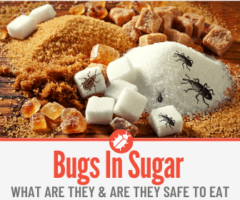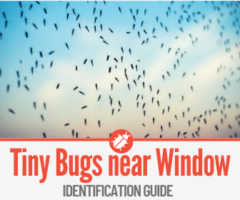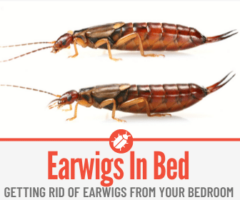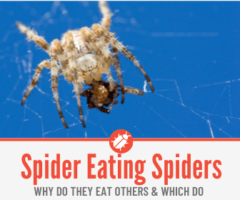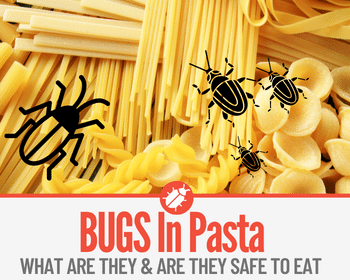 Have you ever opened a box of pasta you were planning on making for dinner, only to find a multitude of insects roaming around in it? Not sure what these bugs are?
Have you ever opened a box of pasta you were planning on making for dinner, only to find a multitude of insects roaming around in it? Not sure what these bugs are?
In this guide you will learn:
- How to identify the Bugs in your Pasta,
- If Pasta with Bugs in it are safe to eat or should be discarded,
- How to prevent Weevils and Different other Bugs in your Pasta.
What are the Tiny Black and Brown Bugs in my Pasta
Generally, the very small black and brown bugs you’ll find in your pasta boxes is what’s called a weevil.
These tiny creatures are in the beetle family of insects and can be found all over the world, but especially in heavy grain growing regions.
Most varieties of weevil can live for between 2 to 4 months and can lay between 200 and 500 eggs during their lifetime. These eggs can be found both in living plants and processed foods such as pasta in your pantry.
Weevils are naturally occurring insects that primarily feed on packaged foods like pasta, sugar, cake mix, cereal, rice and even the occasional granola bar.
Weevils are labeled as pests due to the fact that, not only do they infest packaged food and can ultimately destroy huge amounts of food in a very short time, they have also been known to cause serious damage (and even death) of entire crop fields.
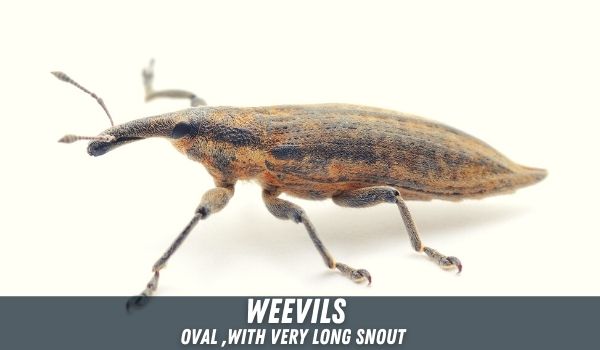
Identifying Different Bugs in Your Pantry & Pasta
Generally, the main kind of insect you’ll find roaming around in your food pantry is going to be a species of weevil or the standard variety of sugar ants.
There are multiple species of weevils that can be found in pasta, however, this will ultimately depend on the type of food they’ve been brought in on.
1.Grain Weevils
Grain weevils (also known as Wheat weevils or Granary weevils) are the most common type that can be found in a pasta, they primarily feed on cereals and oats.
They are generally the fastest to reproduce and the larvae eat entire handfuls of grains as they mature.
2.Rice Weevils
Rice weevils are slightly less common in the Pasta than their grain counterparts, and they primarily feed on grains of rice and maize.
They don’t reproduce as quickly as Grain weevils can and they can live for up to five months in the appropriate conditions in your pasta boxes.
3.Sugar Ants
Sugar ants are not specifically found in grains or grain-based food products such as pasta, however they are still very common in pantries especially as the weather changes in the late spring and early summer.
One colony of sugar ants can include hundreds of different insects, making them very difficult to eradicate from the home. One sugar ant can live up to three months in your pasta, while Queens of the colony live much longer than that.
4.Flour Beetle
While Flour beetles are often confused as weevils when they are found in food products (in fact they are often called Flour Weevils by mistake), these two insects belong to two very different species, although both can be found in the beetle family.
Flour beetles are often a decent bit larger than weevils and live significantly longer lifespans, although their infestations are primarily kept to flour rather than Pasta.
Although they are a bit larger than other beetles that can be found in the pantry, Flour beetles are still completely safe to eat if they get in your pasta. The most concerning factor for most people when it comes to flour beetles is the odor that they release as they eliminate waste from their body.
Larger infestations have also been known on occasion to turn the flour into a grayish color rather than the normal white, although even this color tainted product is perfectly safe to eat and it will not affect the taste of the food in its final form.
Why Are There Bugs in my Pasta and How Did They Get There
It is not at all uncommon to find bugs in your Pasta, and it is by no means a reflection of cleanliness in your home and kitchen, so don’t feel guilty if you find insects crawling around in your sealed packages of pasta and other staple food products.
Insects are generally difficult to spot and remove in food products, and they often slip unnoticed into packaging.
For foods such as oatmeal and rice, the insects lay eggs in the plants themselves and the larvae remain hidden in the individual grains.
As the plants are harvested and packaged by machinery, the eggs and larvae are left in the grains and ultimately transported to the consumer.
As these larvae and eggs mature into adult insects, the cycle continues and the infestation grows and other products in your Pantry get infested.
While the washing and cleansing process in the manufacturing of most food products will usually eliminate any adult insects, the eggs and larvae are generally tucked deep inside the individual grains of food, so the water doesn’t successfully wash them away like it does the adult creatures.
Once they make it safely through the wash cycle, the eggs and larvae have enough oxygen in the containers to finish their maturation and continue to reproduce.
Since Pasta is a processed food, any Bugs that have infested the grains that are used to make pasta would have been killed in the process.
The only way for Bugs and Weevils to get in your pasta is:
- If there is an insect infestation in the warehouses used to store the pasta before it gets to store,
- If there is an Insect Infestation in the store you purchased your pasta from,
- They simply crawled in your pasta box from other infested products in your pantry.
It is likely that any insects you find in your food have been breeding and multiplying since they were even in your home, which could be upwards of months.
How Do I Know If There are Weevils in my Pasta?
In all honesty, unless there’s visible adult insects making their way around your pasta bags, there’s really no way to know if you have an infestation on your hands.
Given that the eggs and larvae are generally too small to see with the naked eye and are imbedded into the individual grains of food, you are not likely to see them in your pantry until they are adults.
What Happens if I Cook and Eat Pasta With Weevils in it?
If you are wondering if you can get sick from Weevils and other bugs in your pasta…
Generally speaking, you are not at all likely to get sick from ingesting bugs in your pasta,
The overwhelming majority of insects that could be found in Pasta are not hosts for parasites that can affect humans, and the cooking process generally filters out any germs that may be left over from the insects as they go through their daily life.
As long as your Pasta is properly cooked and any large bugs are removed before the cooking process begins, you are safe to eat the Pasta.
While having weevils roaming around in your pasta and grains may not be visually appealing, they are perfectly safe to eat.
Chances are, once the pasta is cooked and flavored with whatever sauce your particular recipe calls for, you will more than likely not even notice any insects are in the food.
As a matter of fact, weevils are so small and hard to spot that you may even be eating them without realizing you have an infestation.
Pasta with Weevils is Perfectly safe to eat…
As a general rule, pasta with weevils is perfectly safe to eat and will not cause any harm to humans or even pets.
As mentioned previously, insects that are often found tucked into dry food storage do not contain parasites that threaten humans. Any germs left behind from the excrement of the bugs will be neutralized with high temperatures found in cooking.
While it is certainly not the most pleasant experience finding insects in your food supply, the only thing you have to worry about is damage to the food itself.
Weevils and even sugar ants may look rather disgusting and leave an odd odor, but they are perfectly safe to ingest if that’s the only food you have available to serve.
It is more than likely that once the food is cooked and served, the insects will be undetectable unless you know they are there.
Preventing Weevils in Pasta
Much like sugar ants, if you find yourself with an infestation of weevils it is best to throw out any and all contaminated food to prevent them from spreading.
Once you have all of the contaminated food sources eliminated from the pantry, wipe everything down with a damp cloth soaked in vinegar and allow it to dry before putting anything back.
Regular pest control may help to eliminate the spread of any insects that are brought into the house via food storage, however it is best to clean out your pantry once every few months to ensure no infestations are allowed to get out of hand.
This will also deter sugar ants and other insects from contaminating your Pasta and Other food and causing large infestations.
Found Spiders in your Pantry?
Lastly, it is not uncommon to find spiders in the pantry. They are far less likely to invade your pasta and food supply than the insects mentioned above, however they love cool and dark corners that aren’t often disturbed, which is what makes pantries a great spot for spiders of many varieties.
If they are not a poisonous species of spider, it is best to leave them be as they will help to control other varieties of pests roaming around in your food storage and munching on your pasta.

